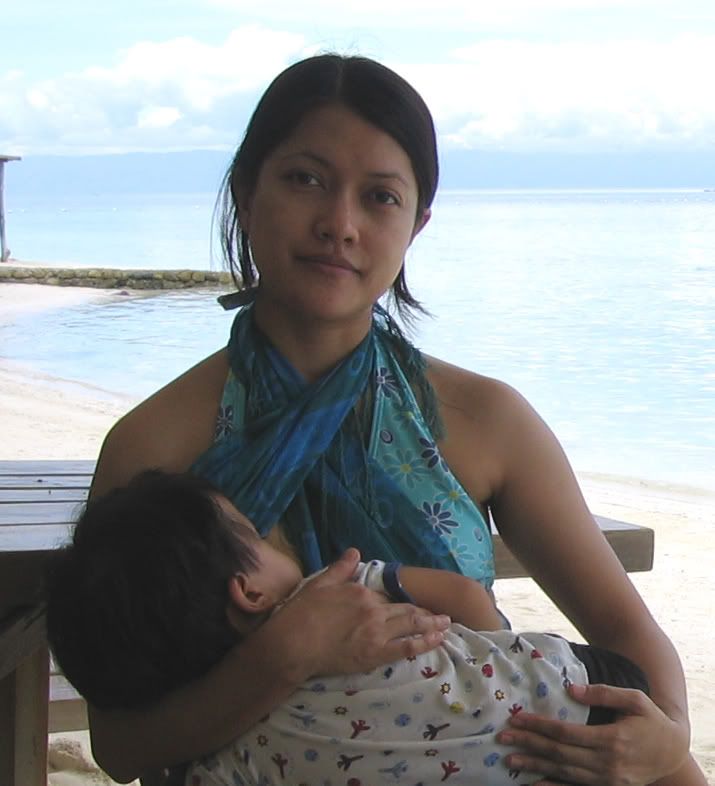On Monday, we had a press briefing for the justice reporters. Previously, the Milk Code issue was being covered by health beat reporters. We wanted to motivate justice reporters to cover the subject as well, particularly the Supreme Court hearing.
On Tuesday, we had the Supreme Court hearing. It was high drama all throughout. Our NGO partners, led by Innes Fernandez, organized a lightning rally in front of the Supreme Court. They bared their breasts to express their outrage that the Milk Code's RIRR was still being held hostage by the Temporary Restraining Order. Need I say that they made the headlines the next day?
The Philippine Daily Inquirer splashed a photo of the "militant breastfeeding mothers" on the front page on 20 June 2007:

Inside, the drama continued. One of the best reports was made by, again, the Philippine Daily Inquirer.
The article quotes the different Supreme Court Justices. My favorite is the description of Chief Justice Reynato Puno's line of questioning:
Chief Justice Reynato Puno for his part said the power of the DoH to formulate rules came from three sources -- the legislation of Congress, international covenants, and the police power of the state.
Illustrating the DoH’s police power, he said that if the department would find rotten milk being sold, it had the power to take it out of the market.
The Pharmaceutical and Healthcare Association of the Philippines and Department of Health have 30 days from 19 June to submit their memoranda to the Supreme Court. We're expecting the Supreme Court's decision shortly therafter, as Chief Justice Puno himself said in later interviews:
"It will not be too long, the issues are not that complicated."
That's what we have been thinking all this time.
On Wednesday, UNICEF and WHO had a joint press conference for the Asia Pacific Regional Consultation on Breastfeeding Protection, Promotion and Support. The reporters came in droves jokingly looking for the bare-breasted women again. The AFP covered the event and its report was published by The Manila Times, among others:

Now if you've read this far, thank you very much! But the week isn't over yet! Thursday evening, we had the premiere screening of "Formula for Disaster". Over 200 guests arrived. A panel of international experts gave their reactions to the video, after which we had a lively discussion with some of the guests. One of them was a member of the Philippine Medical Association, and when he spoke, he sounded very much like the petition that PHAP submitted to the Supreme Court. Of course, our NGO partners could not contain themselves. Dr. Elvira Henares-Esguerra, Executive Director of Children for Breastfeeding, countered by quoting Chief Justice Puno (see a few paragraphs back). And then Innes Fernandez, Executive Director of Arugaan and founder of Save Babies Coalition, Innes of breast-baring fame, gave her usual passionate response.
On Friday, the regional breastfeeding consultation wrapped up in WHO. But before that, I brought David Clark, Project Officer (Legal) of the Nutrition Section in UNICEF New York, to be interviewed on the ABS-CBN News Channel. It was his most surreal interview, because the PHAP lawyer and a business consultant who's on PHAP's side, were interviewed before him. They questioned our statistics, insisted that the exclusive breastfeeding rate was 88% and not 16%, and dared us to produce a single child death that was directly attributable to infant formula. Well, I will do just that on another post.
Finally, the long and intense week was over. I did a phone patch interview for Radio Veritas on Saturday morning. In the afternoon, I barely made it to my godson's baptism (so sorry Mikael!). I got dizzy for a few seconds in the car and considered not going at all. I think it must have been the week of missed lunches, responding to the needs of journalists, and having a teething 9-month-old baby. I think it's called fatigue. But boy, was it worth it.

